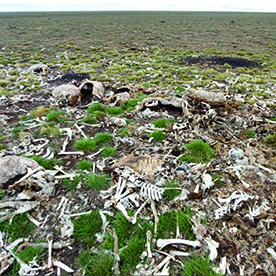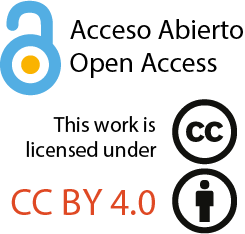RECURRENT DEATHS OF GUANACOS (LAMA GUANICOE) DUE TO WINTER STRESS IN SOUTHERN PATAGONIA: AVERAGED SAMPLES AND CHANGE OF ANALYSIS SCALES
Muertes recurrentes de guanacos (Lama guanicoe) por estrés invernal en el sur de Patagonia: Muestras promediadas y cambio de escalas de análisis
DOI:
https://doi.org/10.5710/PEAPA.02.07.2025.543Keywords:
Actualistic taphonomy, Bone accumulations, Massive deaths, Generic and specific redundancy, Settling in, Accumulation cycles, PatagoniaAbstract
Actualistic taphonomic observations of guanaco carcasses resulting from two winter mass death events that occurred in 2020 and 2023 at various locations in the Coyle-Gallegos River interfluve (Santa Cruz, Argentina) provide valuable information about the formation of the fossil record. In this paper, we discuss how studying these die-offs allows us to monitor the formation of the so-called averaged samples. The longitudinal monitoring of carcass assemblages aggregated in different years forced us to change the scale of analysis, which gradually approached a controlled averaged sample. In this long-term study, we evaluate the main variables involved in the processes of guanaco carcass accumulation, such as the regularity and causes of massive accumulations, the locations of dead guanaco concentrations, the spatial superposition of deaths, and the variation in the size of bone patches due to processes such as carnivore action, trampling, and gravity sliding. For the analysis, we used the concepts of accumulation cycle, tempo, settling in, fossil stability, formational forcing, and retarding factors. Our results allow us to propose various conditions of bone preservation and identify spatial sectors with better burial opportunities, which are useful for constructing long-term viable analogous models, the usual ones of the archaeological and paleontological records.
References
Albrieu, C. & Ferrari, S. (2000). La estepa. In El Gran Libro de la Provincia de Santa (pp. 280–301). Milenio Ediciones y Alfa Centro Literario.
Álvarez, M. C., Gutiérrez, M. A., Massigoge, A., Borrero, L. A., Kaufmann, C. A., Recofsky, M. & Belardi, J. B. (2022). Acumulaciones de Restos Óseos en Nidos de Carancho (Caracara plancus, Aves, Falconiformes) de la Patagonia Austral. Implicaciones Tafonómicas y Arqueológicas. Revista del Museo de Antropología, 15, (3), 219–234. http://doi.org/10.31048/1852.4826.v15.n3.37850
Barberena, R. (2008). Arqueología y Biogeografía Humana en Patagonia Meridional. Sociedad Argentina de Antropología.
Behrensmeyer, A. K. (1978). Taphonomic and ecologic information from bone weathering. Paleobiology, 4,150–162.
Behrensmeyer, A. K. & Hook, R. W. (1992). Paleoenvironmental Contexts and Taphonomic Modes. In A. K. Behrensmeyer, J. D. Damuth, W. A. DiMichele, R. Potts, H-D. Sues & S. L. Wing (Eds.), Terrestrial Ecosystems through Time. Evolutionary Paleoecology of Terrestrial Plants and Animals (pp. 15–136). The University of Chicago Press.
Belardi, J. B. & Rindel, D. (2008). Taphonomic and archaeological aspects of massive mortality processes in guanaco (Lama guanicoe) caused by winter stress in Southern Patagonia. Quaternary International, 180, 38–51. https://doi.org/10.1016/j.quaint.2007.08.021
Belardi, J. B., Carballo Marina, F. & Campan, P. (2022). Distribuciones de artefactos líticos, cronología y el modelo de pisoteo (Borrero 1988): los médanos de la costa norte del lago Viedma (Santa Cruz, Patagonia argentina). Chungara. Revista de Antropología Chilena, 54, 521–534.
Belardi, J. B., Borrero, L.A., Carballo Marina, F., Kaufmann, C. A., Massigoge, A., Álvarez, M. C. & Gutiérrez, M. A. (2025). Modern guanacos (Lama guanicoe) killed by winter stress in Southern Patagonia (Argentina). Taphonomic and Archaeological Implications. In G. Wong & A. Klemmer (Eds.), Zooarchaeology: Beyond Human Subsistence. University of Utah Press. En prensa.
Beldomenico, P. M., Uhart, M., Bono, M. F., Marull, C., Baldi, R. & Peralta, J. L. (2003). Internal parasites of free-ranging guanacos from Patagonia. Veterinary Parasitology, 118, 71–77.
Berger, J. (1983). Ecology and Catastrophic Mortality in Wild Horses: Implications for Interpreting Fossil Assemblages. Science, 220, 1403–1404.
Berger, J. (1986). Wild Horses of the Great Basin: Social Competition and Population Size. University of Chicago Press.
Bernáldez Sánchez, E. (2009). Bioestratinomía de macromamíferos terrestres de Doñana. Inferencias ecológicas en los yacimientos arqueológicos del S.O. de Andalucía. BAR International Series 1978.
Bird, J. B. (1988). Travels and Archaeology in South Chile. University of Iowa Press.
Bonfili, J. O. (2024) Olas de frío en Río Gallegos. Informe técnico inédito. Unidad Académica Río Gallegos, Universidad Nacional de la Patagonia Austral, Río Gallegos. MS.
Borrero, L. A. (1988). Estudios tafonómicos en Tierra del Fuego: su relevancia para entender procesos de formación del registro arqueológico. In H. D. Yacobaccio (Ed.), Arqueología Actualidad y Perspectivas (pp. 13–32). Ediciones Búsqueda.
Borrero, L. A. (1990). Taphonomy of guanaco bones in Tierra del Fuego. Quaternary Research, 34, 361–371.
Borrero, L. A. (2007). Longitudinal Taphonomic Studies in Tierra del Fuego, Argentina. In M. A. Gutiérrez, L. Miotti, G. Barrientos, G. Mengoni Goñalons & M. Salemme (Eds.), Taphonomy and Zooarchaeology in Argentina (pp. 219–233). BAR International Series 1601, Archaeopress.
Borrero, L. A. & Charlin, J. (2010). Arqueología del Campo Volcánico Pali Aike, Argentina. In L. A. Borrero & J. Charlin (Eds.), Arqueología de Pali Aike y Cabo Vírgenes (Santa Cruz, Argentina) (pp. 9–30), CONICET-IMHICIHU.
Burgett, G. R. (1990). The Bones of the Beast: Resolving questions of faunal assemblage formation processes through actualistic research. [Unpublished PhD Thesis]. Department of Anthropology, University of New Mexico.
Darwin, C. (1906) [1839]. Journal of Researches into the Geology & Natural History of the Various Countries Visited During the Voyage of the Beagle Round the World, under the Command of Capt. Fitz Roy. Dent & Sons.
Dawe, R. J. & Kornfeld, M. (2017). Nunataks and Valley Glaciers: Over the Mountains and through the Ice. Quaternary International, 444, 56–71. https://doi.org/10.1016/j.quaint.2017.03.062
de Lamo, D. A., Sanborn, A. F., Carrasco, C. D. & Scott, D. J. (1998). Daily activity and behavioral thermoregulation of the guanaco (Lama guanicoe) in winter. Canadian Journal of Zoology, 76, 1388–1393. https://doi.org/10.1139/z98-070
Ercolano, B., Coronato, A., Tiberi, P., Corbella, H. & Marderwald, G. (2016). Glacial geomorphology of the tableland east of the Andes between the Coyle and Gallegos River valleys, Patagonia, Argentina. Journal of Maps 12, 304–307. https://doi.org/10.1080/17445647.2016.1206840
Estévez Escalera, J. & Mameli, L. (2000). Muerte en el canal: experiencias bioestratinómicas controladas sobre la acción sustractora de cánidos. Archaeofauna, 9, 7–16. https://doi.org/10.15366/archaeofauna2000.9.001
Frison, G. C. (2014). Rancher Archaeologist. A Career in Two Different Worlds. The University of Utah Press.
Gutiérrez, M. A. (2006). Efectos, agentes y procesos tafonómicos en el área Interserrana bonaerense. Relaciones de la Sociedad Argentina de Antropología, XXXI, 201–228.
Gutiérrez, M. A. & Kaufmann, C. A. (2007). Methodological criteria for the identification of formation processes in guanaco (Lama guanicoe) bone assemblages in fluvial-lacustrine environments. Journal of Taphonomy, 5, 151–176.
Hietala, H. J. & Stevens, D. S. (1977). Spatial analysis: multiple procedures in pattern recognition. American Antiquity, 42, 539–559.
Lamuedra González, L. D. (2015). Variables ambientales asociadas a la distribución espacial de guanacos muertos (Lama guanicoe) en la Reserva Provincial Cabo Dos Bahías, Chubut, Argentina. [Unpublished BA thesis]. Universidad Nacional de la Patagonia San Juan Bosco, Sede Puerto Madryn.
Leggieri, L. R., Anello, M., Peralta, D., Túnez, J. I., Di Rocco, F., Poljak, S., Flores, C., Alunni, D., Belardi, J. B., Gutiérrez, M. A, Álvarez, M. C., Massigoge, A., Kaufmann, C. A., Borrero, L. A., Borghi, C., Demartini, J., Petracci, P., Sotelo, M., Marbán, L., Kathiravan, P., Rudolf, P., Marín, J. C., Cárcamo, J. G. & Carmanchahi, P. (2024). Delineating genomic features for wild guanaco conservation. Biological Journal of the Linnean Society, 143, blae087. https://doi.org/10.1093/biolinnean/blae087
Lepetz, S., Lefèvre, C. & Pellé, E. (2003) Los guanacos de la turbera: nota sobre un depósito natural. Magallania, 31, 415-418.
L’Heureux, G. L. & Borrero, L. A. (2002). Pautas para el reconocimiento de conjuntos óseos antrópicos y no antrópicos de guanaco en Patagonia. Intersecciones en Antropología, 3, 29–40.
Manero, A. (2000). Los mamíferos de Santa Cruz. In El Gran Libro de la Provincia de Santa Cruz, Tomo 1, (pp. 311–319). Milenio Ediciones y Alfa Centro Literario.
Martin, P. S. (1973). The discovery of America. Science, 179, 969–974. https://doi.org/10.1126/science.179.4077.969
Martin, F. M. & Borella, F. (1999). Tafonomía de Tierra del Fuego: reevaluación de la arqueología de Cabeza de León. In J. B. Belardi, P. M. Fernández, R. A. Goñi, A. G. Guráieb & M. De Nigris (Eds.), Soplando en el viento… Actas de las III Jornadas de Arqueología de la Patagonia (pp. 439–450). Instituto Nacional de Antropología y Pensamiento Latinoamericano - Universidad Nacional del Comahue. Universidad Nacional del Comahue.
Martinka, C. (1967). Mortality of northern Montana pronghorns in a severe winter. Journal of Wildlife Management, 31, 159–164.
Massigoge, A., Rafuse, D. J., Álvarez, M. C., González, M. E., Gutiérrez, M. A., Kaufmann, C. A. & Scheifler, N. A. (2015). Beached penguins on the Atlantic Coast in the Pampas region of Argentina: Taphonomic analysis and implications for the archaeological record. Palaeogeography, Palaeoclimatology, Palaeoecology, 436, 85–95. https://doi.org/10.1016/j.palaeo.2015.06.045
Nasti, A. (1994–1995). Desarticulación natural y supervivencia de partes anatómicas: tafonomía de vertebrados modernos en medioambientes puneños. Palimpsesto. Revista de Arqueología, 4, 70–89.
Nash, D. T. & Petraglia, M. D. (1987). Natural Formation Processes and the Archaeological Record: Present Problems and Future Requisites. In D. T Nash & M. D. Petraglia (Eds.), Natural Formation Processes and the Archaeological Record (pp. 186–204). BAR International Series 352. Archaeopress.
Okarma, H., Jędrzejewska, B., Jędrzejewski, W., Krasiński, Z. A. & Miłkowski, L. (1995). The roles of predation, snow cover, acorn crop, and man-related factor of ungulate mortality in Białowieża Primeval Forest, Poland. Acta Theriologica, 40, 197–217.
Oliva, G., González, L., Rial, P. y Livraghi, E. (2001). Áreas ecológicas de Santa Cruz y Tierra del Fuego. En P. Borrelli & G. Oliva (Eds.), Ganadería ovina sustentable en la Patagonia austral. Tecnología de Manejo Extensivo (pp. 41–82). Ediciones Instituto Nacional de Tecnología Agropecuaria.
Oyarzabal, M., Clavijo, J., Oakley, L., Biganzoli, F., Tognetti, P., Barberis, I., Maturo, H. M., Aragón, R., Campanello, P. I., Prado, D., Oesterheld, M. & León, R. J. C. (2018). Unidades de vegetación de la Argentina. Ecología Austral, 28, 40–63. https://doi.org/10.25260/EA.18.28.1.0.399
Ozán, I. L., Borrero, L. A., Borrazzo, K. & L´Heureux, G. L. (2015). Tafonomía en pendientes: El caso de cerro Sin Nombre (Tierra del Fuego, Argentina). In J. Rubin de Rubin & C. Favier Dubois (Eds.), Geoarqueologia na América do Sul (pp. 285–330). Universida de Pontificia.
Peri, P. L.; Gaitán, J., Díaz, B., Almonacid, L., Morales, C., Ferrer, F., Lasagno, R., Rodríguez-Souilla, J. & Martínez Pastur, G. (2024). Vegetation Type Mapping in Southern Patagonia and Its Relationship with Ecosystem Services, Soil Carbon Stock, and Biodiversity. Sustainability, 16(5), 2025. https://doi.org/10.3390/su16052025
Petraglia, M. D. & Nash, D. T. (1987). The impact of Fluvial Processes on Experimental Sites. In D. T. Nash & M. D. Petraglia (Eds.), Natural Formation Processes and the Archaeological Record (pp. 108–130). BAR International Series 352. Archaeopress.
Prichard, H. (2003) [1902]. En el corazón de Patagonia. Zagier & Urruty Publications.
Prieto, A., Stutz, S. & Pastorino, S. (1999). Arqueopalinología de la Cueva Las Buitreras (Provincia de Santa Cruz, Argentina). Praehistoria, 3, 169–181.
Rial, P. (2001). Grandes unidades de paisaje. In P. Borrelli & G. Oliva (Eds.), Ganadería ovina sustentable en la Patagonia austral. Tecnología de Manejo Extensivo (pp. 22–40). Ediciones Instituto Nacional de Tecnología Agropecuaria.
Rindel, D. & Belardi, J. B. (2006). Mortandad catastrófica de guanacos por estrés invernal y sus implicaciones arqueológicas: el sitio Alero Los Guanacos 1, lago Cardiel (Provincia de Santa Cruz, Argentina). Magallania, 34, 139–155. http://dx.doi.org/10.4067/S0718-22442006000100009
Rogers, R. R. & Kidwell, S. M. (2007). A Conceptual Framework for the Genesis and Analysis of Vertebrate Skeletal Concentrations. In R. R. Rogers, D. A. Eberth & A. Fiorillo (Eds.), Bonebeds: Genesis, Analysis, and Paleobiological Significance (pp. 1–62). The University of Chicago Press.
Schaller, G. & Junrang, R. (1988). Effects of a snowstorm on Tibetan Antelope. Journal of Mammalogy, 69, 631–634. https://doi.org/10.2307/1381361
Scorolli, A. L., López Cazorla, A. C. & Tejera, L. A. (2006). Unusual Mass Mortality of Feral Horses during a Violent Rainstorm in Parque Provincial Tornquist, Argentina. Mastozoología Neotropical, 13, 255–258.
Speth, J. D. & Spielmann, K. A. (1983). Energy source, protein metabolism, and hunter-gatherer subsistence strategies. Journal of Anthropological Archaeology, 2, 1–31. https://doi.org/10.1016/0278-4165(83)90006-5
Sturzenbaum, P. & Borrelli, P. (2001). Manejo de riesgos climáticos. In P. Borrelli & G. Oliva (Eds.), Ganadería Ovina Sustentable en la Patagonia Austral. Tecnologías de Manejo Extensivo. INTA-Santa Cruz (pp. 255–270). Editorial Erre Gé & Asociados.
Sutcliffe, A. J. (1990). Rates of Decay of Mammalian Remains in the Permafrost of Canadian High Arctic. In C. R. Harington (Ed.), Canada's Missing Dimension: Science and History in the Canadian Arctic Islands, v. 1 (pp. 161–186). Canadian Museum of Nature.
Todd, L. C. (1987). Taphonomy of the Horner II Bone Bed. In G. C. Frison & L. C. Todd (Eds.), The Horner II Site: The Type Site of the Cody Cultural Complex (pp. 107–198). Academic Press.
Tonni, E. P., Bonini, R. A., Molinari, A. E., Pomi, L. H., Prevosti, F. J., Carbonari, J. E. & Huarte, R. (2008). Análisis radiocarbónico en una tafocenosis de la región pampeana (provincia de Buenos Aires, Argentina): su vinculación con la Gran Seca de 1827-1832. Intersecciones en Antropología, 9, 307–311.
Vázquez, M., 2006. Tafonomía de la muerte y parámetros poblacionales. Guanacos en las bahías Valentín y Cambaceres, costa sur de Tierra del Fuego. In A. G. Austral & M. Tamagnini (Comp.), Problemáticas de la Arqueología Contemporánea (pp. 239–241). Universidad Nacional de Río Cuarto.
Wang, X. & Martin, L. (1993). Natural Trap Cave. National Geographic Research & Exploration, 9, 422–435. https://doi.org/10.1016/j.quaint.2023.01.007
Warchałowski, M., Nowakowski, P. & Dancewicz, A. (2015). Effect of winter conditions on wild ungulates mortality in the Owl Mountains (Poland). Folia Forestalia Polonica, series A, 57, 187–193. https://doi.org/10.1515/ffp-2015-0018
Weigelt, J. (1989) [1927]. Recent Vertebrate Carcasses and Their Paleobiological Implications. The University of Chicago Press.

Additional Files
Published
Issue
Section
License
Copyright (c) 2025 Luis Alberto Borrero, María A. Gutiérrez, Agustina Massigoge, Juan Bautista Belardi, Cristian A. Kaufmann, María Clara Álvarez

This work is licensed under a Creative Commons Attribution-NoDerivatives 4.0 International License.
Authors retain copyright and grant the journal right of first publication with the work simultaneously licensed under a Atribución/Reconocimiento 4.0 Internacional that allows others to share the work with an acknowledgement of the work's authorship and initial publication in this journal.















